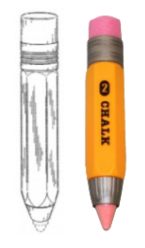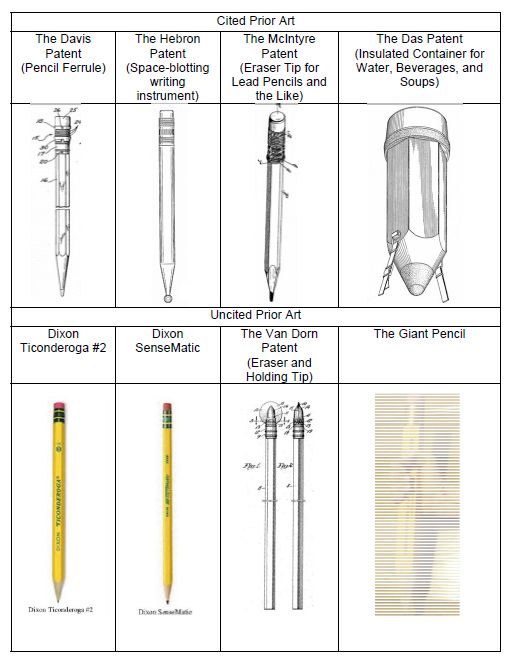Lanard Toys Limited v. Dolgencorp LLC, JA-RU, Inc., Toys "R" US-Delaware, Inc. (Fed. Cir. 2020)
In a recent precedential opinion, the Federal Circuit noted that the district court followed the Federal Circuit's "claim construction directives to a tee." Here, the design patent at issue contained both functional and non-functional elements. Accordingly, litigants or potential litigants involving design patents having functional and non-functional elements are encouraged to review this decision to better understand the scope of enforcement of the at-issue design patent(s).
Lanard Toys ("Lanard") obtained U.S. Design Patent No. D671,167 (the "D167 patent") and began selling a toy chalk holder to Dolgencorp LLC ("Dolgencorp") and Toys "R" US-Delaware ("TRU"). JA-RU, Inc. ("JA-RU") subsequently began selling its toy chalk holder to Dolgencorp and TRU. Lanard brought suit in the Middle District of Florida and, among other claims, asserted design patent infringement of its D167 patent. The District Court held that the JA-RU product does not infringe the D167 patent. During claim construction, the District Court noted that the functional characteristics of the D167 patent limit the scope of the protected subject matter. The court indicated that the design consists of four elements: the conical tapered piece, hexagonal elongated body, cylindrical ferrule, and the columnar eraser. The District Court then noted the functional purpose of each element: the conical tapered piece holds the chalk in place for writing, the elongated body stores the chalk, the ferrule attaches the eraser to the body, and the eraser erases. "[W]hile the functional elements of the patented design are not protected on a conceptual level, there is no evidence that the particular ornamental designs adorning these elements are essential to the use of the article,"1 which includes the grooves of the ferrule, the smooth surface and straight taper of the conical piece, and the specific proportional size of these elements to each other. "[T]he scope of the D#167 Patent is limited to the ornamental aspects of the design, and not the underlying functional design elements."2

D167 patent (Fig.
1) JA-RU Product
The District Court next examined the prior art and noted that "the overall appearance of Lanard's design [D167 patent] is distinct from this prior art only in the precise proportions of its various elements in relation to each other, the size and ornamentation of the ferrule, and the particular size and shape of the conical tapered end."3

Using this claim construction, the District Court reasoned that the "design similarities [between the D167 product and the JA-RU product] stem from the aspects of the design that are either functional or well-established in the prior art" to hold that the JA-RU product does not infringe the D167 patent.
Lanard appealed and the Federal Circuit affirmed the District Court's non-infringement determination. Using the ordinary observer test and the District Court's claim construction, the Federal Circuit stated that the "[district] court necessarily considered how the ornamental differences in each element would impact the ordinary observer's perception of the overall designs."4 A correct balance of ornamental aspects of the design and how an ordinary observer would view the overall design was utilized. Further and given the robust amount of prior art, "small differences between the accused design and the claimed design are likely to be important to the eye of the hypothetical ordinary observer."5
A key point was the Federal Circuit disregarding Lanard's argument highlighting the similarities between Lanard's product and JA-RU's product as toy chalk holders to sustain its infringement allegation.
While the Federal Circuit gave a stamp of approval of the District Court's claim construction analysis, this decision seemingly minimizes the effect of the title of the design on claim construction during an infringement analysis. The D167 patent is titled "Chalk Holder," yet the Federal Circuit refused to construct the scope of the design to be the ornamental aspect of a "chalk holder" and instead construed the design more broadly. While important for validity and the initial classification of the design application for examination purposes, the intended use of the design appears to play a less important role – at least in this case – in the infringement analysis.
Footnotes
1. Lanard Toys Limited v. Toys "R" US-Delaware, Inc., Dolgencorp, LLC, and JA-RU, Inc., (Mid. Dist. Florida 2019), p. 30.
2. Id. at 31.
3. Id. at 34.
4. Lanard Toys Limited v. Dolgencorp LLC, JA-RU, Inc., Toys "R" US-Delaware, Inc. (Fed. Cir. 2020) at p. 9.
5. Id. at 10.
Originally published 18 May, 2020
The content of this article is intended to provide a general guide to the subject matter. Specialist advice should be sought about your specific circumstances.

